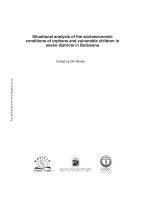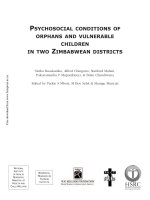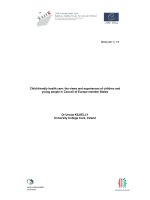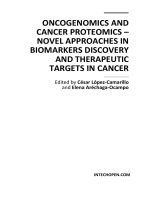Identification of oct4 and sox2 targets in mouse embryonic stem cells
Bạn đang xem bản rút gọn của tài liệu. Xem và tải ngay bản đầy đủ của tài liệu tại đây (10.7 MB, 270 trang )
IDENTIFICATION OF OCT4 AND SOX2 TARGETS IN MOUSE
EMBRYONIC STEM CELLS
CHEW JOON LIN
(M.Sc., NUS)
A THESIS SUBMITTED
FOR THE DEGREE OF DOCTOR OF PHILOSOPHY
DEPARTMENT OF BIOLOGICAL SCIENCES
NATIONAL UNIVERSITY OF SINGAPORE
2007
ii
ACKNOWLEDGEMENTS
I am grateful to my supervisor, Dr Ng Huck Hui, who has taught me a great deal about working in
a very competitive field. Thank you for your leadership and guidance throughout the four and a
half years working with you. Thank you for seeing my thesis through.
I am indebted to my committee members:
Professor Hew Choy Leong for your untiring counsel, objectivity, support and feedback
Associate Professor Larry Stanton for untiring counsel, objectivity, support and feedback
Associate Professor Gong Zhiyuan for your kindness, support and feedback
Special thanks to:
Dr Paul Robson for invaluable discussions and feedback particularly on the Sox2 project
Associate Professor Lim Bing for encouragements and feedback
Associate Professor Thomas Lufkin for some discussions on ESC culture
Dr Neil Clarke for your student counsel and support
Associate Professor Nallasivam Palanisamy for laughter shared during late nights and weekends
Dr Edwin Cheung for presentation feedback
Prof Alex Ip for your invaluable knowledge on teaching and presentation methods
Prof Larry Stanton, Prof Hew Choy Leong, Dr Patrick Ng Wei Pern, Wong Meng Kang, Lo Ting
Ling and Wong Kee Yew for reviewing and commenting on this thesis
Many thanks to collaborators in this work and side projects, particularly:
Dr Ruan Yijun, Dr Wei Chia-Lin, Dr Paul Robson, Associate Professor Larry Stanton, Associate
Professor Lim Bing, Vinsensius Berlian Vega, Dr Bernard Leong, Charlie Lee, Dr Leonard
Lipovich, Dr Vladamir Kuznetsov, Wong Kee Yew, Dr Zhao Xiaodong, Lim Leng Hiong, Loh
Yuin Han, Li Pin. Thank you to the GIS sequencing facility for massive sequencing of the ChIP-
PETs and the Bioinformatics group for high throughput computational work.
Special thanks to the Singapore Millennium Foundation, Temasek Holdings and Mr. John deRoza
for financial support and counsel.
I am very blessed to have great labmates, past and present, especially:
Chen Xi, Dr Wu Qiang, Lim Ching Aeng, Dr Zhang Wensheng, Winston Chan, Dr Yan Junli, Dr
Fengbo, Dr Yuan Ping, Kenny Chew, Chia Nayu, Tay Hwee Goon, Fan Yi, Dr Julia Zhu, Katty
Kuay and Tan Qiu Li: thanks for the many discussions and outings!
To all GIS inhabitants, especially:
Clara Cheong, Sumantra, Evan, Serene, Alicia, Sandy, Say Li, Dr Patrick Ng, Pauline, Govind, Dr
Sanjay Gupta, Dr Mani, Dr Srini, Meng, Dr Majid, Dr Andrew Thomson, and all the
administrative personnel at level 2: thank you for all the good memories.
Thanks to the Genome Institute of Singapore and National University of Singapore for facility
support, administrative assistance and good services rendered.
Thank you SMF-ers Chia Jer Ming, Lynn Chiam, Chang Kai Chen, Azhar Ali, Chang Ti Ling and
many others, for a great fellowship!
Special thanks to my family members who sacrificed the most but ironically, may not understand
much beyond this page: I love you.
iii
TABLE OF CONTENTS
TITLE PAGE i
ACKNOWLEDGEMENT ii
TABLE OF CONTENTS iii
SUMMARY xi
LIST OF TABLES xiii
LIST OF FIGURES xiv
LIST OF ABBREVIATIONS xviii
LIST OF PUBLICATIONS xix
CHAPTER I
General Introduction
1.1 Stem cells 1
1.2 Embryonic stem cells (ESCs) 2
1.3 Properties of mouse ESCs (mESCs) 3
1.3.1 Differentiation of mESCs 4
1.4 Maintaining mESCs in their undifferentiated state 7
1.4.1 Signaling pathways 8
1.4.1.1 LIF-STAT3 signaling 8
1.4.1.2 BMP signalling 11
1.4.2 Key transcription factors controlling pluripotency 12
1.4.2.1 Oct4 12
1.4.2.1.1 Oct4 structure 12
iv
1.4.2.1.2 Oct4 expression and function 14
1.4.2.1.3 Regulation of Oct4 expression 15
1.4.2.2 Sox2 16
1.4.2.2.1 Oct4 and Sox2 partnership 18
1.4.2.3 Nanog 20
1.4.2.4 Other transcription factors in the maintenance of mESC 21
1.5 Cell cycle and proliferation of mESCs 22
1.6 Epigenetic modifications in mESCs 22
1.7 Building the transcriptional network in mESCs 23
1.7.1 Transcriptional regulators 23
1.7.2 Technologies for studying the transcriptome 24
1.7.2.1 Transcriptional profiling 24
1.7.2.2 RNAi screen 26
1.7.2.3 In vivo analysis of transcription factor-DNA interactions 26
1.7.2.3.1 Chromatin immunoprecipitation (ChIP) 27
1.7.2.3.2 ChIP-Paired-end ditag (PET) technology 29
1.7.2.3.3 ChIP-on-chip 31
1.8 Aim and experimental approach 32
CHAPTER 2
MATERIALS AND METHODS
2.1 Chemicals and reagents 33
2.2 Antibodies 33
2.3 Recombinant DNA manipulations 34
2.4 SDS-PAGE, Western blots and immunodetection 35
v
2.5 Cell Culture 36
2.5.1 Feeder-free mESC culture 36
2.5.2 Differentiation of mESCs 36
2.5.3 Defined serum-free mESC culture 37
2.5.3.1 Low density plating assay 37
2.5.4 LIF and BMP treatment of serum-free, feeder-free mESC 37
2.5.5 Human ESC Culture 38
2.5.6 HEK293T cell culture 38
2.6 Cell Images 38
2.7 Transfection of mammalian cells 39
2.8 Preparation of nuclei extracts from mESCs 39
2.9 Preparation of whole cell lysates 40
2.10 RNA extraction and Reverse Transcription (RT)-PCR 40
2.11 Chromatin Immunoprecipitation (ChIP) 41
2.11.1 Crosslinking of cells and chromatin extract preparation 41
2.11.2 Immunoprecipitation 42
2.12 Picogreen DNA quantitation 43
2.13 Q-PCR primer designs 43
2.14 Real-time quantitative PCR (q-PCR) 43
2.15 ChIP-PET (paired-end ditag) cloning and sequencing 44
2.15.1 Manual and computer-assisted de novo motif search 44
2.15.2 Computational co-motif enrichment analysis 46
2.16 Sequential chromatin immunoprecipitation (seqChIP) 47
2.17 ChIP on NimbleGen DNA Microarray 48
2.17.1 Ligation-mediated PCR 48
2.17.2 Labeling, hybridization and analyses 49
vi
2.18 Dual-luciferase reporter assay 50
2.19 RNAi-mediated depletion of Oct 4 and Sox2 in mESCs 51
2.20 Overexpression of Oct4 and Sox2 proteins in HEK293T cells 52
2.21 Electrophoretic mobility shift assay (EMSA) 53
2.22 Co-Immunoprecipitation (Co-IP) of protein complexes 53
2.23 Error bars in figures 54
2.24 Contribution of collaborators 54
CHAPTER 3
Establishing the Circuitry of Oct4, Sox2 and Nanog in Embryonic Stem Cells
3.1 Introduction 55
3.2 Results 57
3.2.1 Optimisation of the Oct4 and Sox2 ChIP assays 57
3.2.2 Oct4 and Sox2 bind to the distal enhancer of Oct4 in mESCs 58
3.2.3 Oct4 and Sox2 bind to the SRR2 of Sox2 in mESCs 59
3.2.4 Oct4 and Sox2 bind to the Nanog promoter in mESCs 60
3.2.5 OCT4 and SOX2 bind to the CR4 region of OCT4, SRR2 region of SOX2
and promoter region of NANOG in hESCs 60
3.2.6 Conserved elements in the CR4 region of Oct4 promoter, SRR2 region
of Sox2 enhancer and promoter region of Nanog 61
3.3 Discussion 62
3.3.1 Oct4, Sox2 and Nanog circuitry in ESCs 62
3.3.2 Network motifs in the Oct4, Sox2 and Nanog circuit 63
3.3.3 Conjectures 65
vii
CHAPTER 4
Genome-wide Mapping of Oct4-DNA Interactions in Mouse Embryonic Stem Cells
4.1 Introduction 74
4.2 Results 76
4.2.1 Optimisation of large-scale ChIP 76
4.2.2 Global mapping of Oct4 binding sites in mESCs 77
4.2.3 Oct4 ChIP-PET experiment identifies known Oct4 binding targets 79
4.2.4 Annotation of Oct4 binding sites to the transcriptome of ESCs 80
4.2.5 Identification of novel Oct4 bound genes and associated pathways 82
4.3 Discussion 83
CHAPTER 5
Genome-wide Identification of Sox2-DNA Interactions in Mouse Embryonic Stem Cells
5.1 Introduction 95
5.2 Results 96
5.2.1 Optimisation of ChIP and global mapping of Sox2 binding sites in mESCs 96
5.2.2 Sox2 ChIP-PET experiment identifies known Sox2 targets 98
5.2.3 Linking the Sox2 binding sites to the transcriptome of mESCs 98
5.2.4 Comparative location analyses of Sox2 and Oct4 100
5.3 Discussion 100
viii
CHAPTER 6
Analyses of the Combined Oct4 and Sox2 DNA Binding Sites
6.1 Introduction 114
6.2 Results 115
6.2.1 Oct4 and Sox2 co-occupy shared binding sites 115
6.2.1.1 Comparative location analyses of Oct4 and Sox2 115
6.2.1.2 Oct4 and Sox2 co-occupy on the same DNA molecules 116
6.2.2 Regulation of target genes by Oct4 and Sox2 116
6.2.3 Identification of the joint Sox2-Oct4 DNA binding motif 118
6.2.4 Characterization of the Sox2-Oct4 DNA binding motif 119
6.2.4.1 Interactions of Sox2 and Oct4 with the Sox2-Oct4 joint motifs 119
6.2.4.1.1 Sox2 and Oct4 bind to the Sox2-Oct4 DNA motif in vitro 119
6.2.4.1.2 Mutation of Sox2 and Oct4 DNA motif sequences
abolished binding 120
6.2.4.1.3 Sequences flanking the Sox2-Oct4 DNA motif are
not essential for binding 121
6.2.4.2 The Sox2-Oct4 joint motif sequences are functional 122
6.2.4.2.1 The Sox2-Oct4 motifs confer reporter activities
which are Oct4 and Sox2-dependent 122
6.2.4.2.2 The orientation of the Sox2-Oct4 DNA motif
is important important in conferring reporter activity 123
6.3 Discussion 124
ix
CHAPTER 7
Discovery of Oct4 and Sox2 Collaborating Factors and Demonstrating a Link between
Different Pathways in Mouse Embryonic Stem Cells
7.1 Introduction 138
7.2 Results 140
7.2.1 Stat3 and Smad1 as Oct4 and Sox2 collaborative factors 140
7.2.1.1 Expansion of combined Oct4 and Sox2 ChIP-PET binding data 140
7.2.1.2 Matching of binding site sequences against TRANSFAC database
identified putative co-motifs 141
7.2.1.3 Co-localisation of Stat3 and Smad1 to Oct4 and Sox2 binding sites 141
7.2.1.4 ChIP-on-chip 142
7.2.1.5 Scanning ChIP-qPCR 142
7.2.1.6 ChIP-qPCR of Oct4, Sox2, Stat3, Smad1 on 25 loci 142
7.2.1.7 Co-occupancy of Oct4 with Stat3 and Smad1 on the same
DNA molecule 144
7.2.1.8 Retinoic acid differentiation affects Stat3 and Smad1 binding 144
7.2.1.9 RNAi-mediated depletion of Oct4 and Sox2 affects Stat3 and Smad1
binding 145
7.2.1.10 Stat3 and Smad1 are Oct4 protein partners 146
7.2.2 The connection between Stat3, Oct4 and Nanog pathways 146
7.2.2.1 Culturing mESCs in defined media containing BMP4 and LIF 146
7.2.2.2 Stat3 depletion in mESCs 147
7.2.2.3 Stat3 binds to but does not regulate Oct4 147
7.2.2.4 Stat3 binds to its own gene, providing a model for autoregulation 148
7.2.2.5 Stat3 regulates Nanog 148
x
7.3 Discussion 149
7.3.1 Cofactors collaborating with Oct4 and Sox2 in cis-regulatory modules 149
7.3.2 Molecular mechanisms in the maintenance and differentiation of mESCs 150
CHAPTER 8
General Discussion
8.1 Implications of the study 177
8.2 Future studies 179
REFERENCES 183
APPENDICES
A Coordinates of 1083 Oct4 binding loci and their associated genes. 209
B Coordinates of 1133 Sox2 binding loci and their associated genes 227
C Overlapping Sox2, Oct4 and Nanog associated genes (triple overlaps) viewed
in a (A) 20K window and a (B) 50K window 246
D Oct4, Sox2, Nanog triple sequential ChIP 247
E Oligo probe sequences for reporter assay 248
F Control ChIP-on-chip (H4K20Me3) for ChIP-on-chip experiments in Figure 6.3
and Figure 7.5 249
G Coordinates for ChIP-qPCR amplicons representing peak enrichments in Figure 7.6
and Figure 7.7 251
xi
SUMMARY
Embryonic stem cells (ESCs) are derived from the inner cell mass (ICM) of the mammalian
blastocyst. They are capable of indefinite self-renewing cell division under specific cell culture
conditions for extended periods and they have the ability to differentiate into all cell types of the
adult organism. This property of ESCs holds great promise for regenerative therapeutic medicine.
The fundamental understanding of the molecular biology of ESCs will be essential for the eventual
rational design of methods to control the self-renewal and differentiation of these cells.
Oct4 and Sox2 are key transcription factors that are important in maintaining the ESC
state. In order to understand the roles of these factors and how they collaborate with each other, it
is essential to know which genes are directly associated with these proteins in vivo. In this study,
chromatin immunoprecipitation (ChIP) was used in a small scale study to map the binding
circuitry of Oct4 and Sox2 on Oct4, Sox2 and Nanog genes. Oct4 and Sox2 were shown to bind to
the genes encoding Oct4, Sox2 and Nanog.
Subsequently, the ChIP-PET (paired end ditag) technology was used to map the whole
genome binding sites of Oct4 and Sox2. Thousands of novel Oct4 and Sox2 binding sites were
identified, mapping to genes implicated in important cellular functions including maintenance of
pluripotency. Oct4 and Sox2 were found to co-occupy a substantial number of genes. A fifteen
nucleotide Sox2-Oct4 motif was identified and characterized.
In order to identify other DNA binding transcription factors that may work together with
Oct4 and Sox2, 500 bp DNA sequences centered on the sites bound by Oct4 and Sox2 were
matched against matrices from the TRANSFAC database to reveal putative transcription factor co-
motifs. Two of the extrinsic signaling substrates, Stat3 and Smad1, were shown to bind in the
xii
vicinity of Oct4 and Sox2 DNA binding sites associated with genes important in cell cycle
regulation, pluripotency and self-renewal. Stat3 and Smad1 were further demonstrated to be Oct4
partners, revealing the connection between the intrinsic transcription factors and extrinsic
signaling pathways in mouse embryonic stem cells (mESCs). Stat3 and Oct4 were shown to bind
to the promoter of Nanog, and subsequent results suggest that Stat3 may regulate the transcription
of Nanog. This may provide a link between the three transcriptional pathways in mESCs.
Together, these results suggest that Oct4 and Sox2 (1) have multiple DNA binding sites, (2) may
exert transcriptional effects from distal locations, (3) work in collaboration with other transcription
factors and (4) their binding may be a pre-requisite for the binding of other transcription factors.
In conclusion, this study identified the Oct4 and Sox2 DNA interactions, characterized the
joint DNA motif, expanded the Oct4 and Sox2 transcription binding network to the Smad1 and
Stat3 signalling networks and utilized these binding data in an attempt to answer a long standing
hypothesis of a crosstalk between the Oct4, Stat3 and Nanog transcriptional pathways. The
findings obtained here may contribute to the eventual mapping of the whole transcriptional
regulatory network and elucidation of transcriptional mechanisms in mESCs.
xiii
LIST OF TABLES
4.1 Molecular function of Oct4 target genes.
7.1 List of putative Oct4 and Sox2 co-occurring motifs denoted by their TRANSFAC matrix
ID.
7.2 Function of genes associated with the binding of Oct4, Sox2, Stat3 and Smad1 in mouse
embryonic stem cells as annotated in NCBI.
xiv
LIST OF FIGURES
Figure
1.1 A schematic view of mouse pre-implantation development.
1.2 Mouse embryonic stem cell (mESC) culture, self-renewal and differentiation.
1.3 A model for combinatorial extrinsic signaling and intrinsic transcription factor pathways
in the maintenance of mESC pluripotency and self-renewal.
1.4 Chromatin immunoprecipitation (ChIP) for the study of transcription factor DNA binding
sites (TFBSs) in living cells.
1.5 The Chromatin immunoprecipitation paired-end ditag (ChIP-PET) approach.
3.1 Specificity of αOct4 and αSox2 antibodies used in ChIP.
3.2 Oct4 and Sox2 binding to Oct4 CR4 region in mESCs.
3.3 Oct4 and Sox2 binding reduces after retinoic acid differentiation of mESCs.
3.4 Oct4 and Sox2 bind to the SRR2 at the 3’ enhancer of Sox2 in mESCs.
3.5 Oct4 and Sox2 bind to the Nanog promoter in mESCs.
3.6 OCT4 and SOX2 bind to the distal enhancer (DE)/CR4 region of OCT4, the SRR2 region
of SOX2 and promoter region of NANOG in living human ESCs.
3.7 Multiple alignment analysis of Oct4 and Sox2 binding sites in mESCs from this study and
previous studies (Utf1, Fbx15, Fgf4) identified the Sox-Oct composite element.
3.8 Oct4, Sox2 and Nanog circuitry and network motifs.
4.1 Diagram illustrating the features of the ChIP-PET readout.
4.2 Determination of the minimum PET cluster size as Oct4 bona fide binding sites.
4.3 Profiles of Oct4 binding revealed by ChIP-PET. Validation of known Oct4 occupied genes
in mESCs.
4.4 Annotation of Oct4 binding sites in relation to genomic locations.
4.5 Novel genes bound and potentially regulated by Oct4 in mESCs.
xv
4.6 Retinoic-acid induced differentiation reduces Oct4 binding levels on targets in mESCs.
5.1 Determination of PET cluster size as Sox2 bona fide binding sites.
5.2 Validation of Sox2 binding profiles at the Oct4 upstream regulatory regions.
5.3 Sox2 binding on Sox2 and Nanog from the ChIP-PET data. Image captures of the T2G
browser showing Sox2 PETs at the previously known and validated regions of (A) Sox2
and (B) Nanog.
5.4 Annotation of Sox2 binding sites in relation to genomic locations.
5.5 Binding of Sox2 on microRNA genes.
5.6 Sox2 and Oct4 ChIP-PET binding profiles at (A) Rest and (B) Mycn (C) Oct4, (D)
Sox2,
and (E) Esrrb.
6.1 Venn diagram indicating the extent of overlap between genes associated with Sox2 and
Oct4 binding in mESCs.
6.2 Co-occupancy of Oct4 and Sox2 on target sites.
6.3 ChIP-on-chip data showing co-occupancy of Oct4 and Sox2 on genes marked by
H3K4Me3.
6.4 Identification of the 15 nucleotide Sox2-Oct4 joint consensus motif in the Oct4 and Sox2
ChIP-PET datasets.
6.5 Binding of Oct4 and Sox2 overexpressed (OE) proteins on biotin-labelled DNA probes
containing Oct4 and Sox2 binding sites using EMSA.
6.6 Endogenous native Oct4 and Sox2 bind to the composite Sox2-Oct4 joint motif of Ebf1.
6.7 Mutations within the Sox2-Oct4 element of Rest abolished the Sox2/Oct4-DNA complex.
6.8 Flanking sequences of the Sox2-Oct4 joint motif do not affect Sox2 or Oct4 binding.
6.9 Increased reporter activity conferred by the Sox2-Oct4 elements.
6.10 Swapping the orientation of Sox2-Oct4 motifs to Oct4-Sox2 abolished enhancer activity.
7.1 Model of the integrated roles of Oct4, Nanog and LIF (Stat3) on embryonic stem cell fate
specification, according to different Oct4 and Nanog levels.
xvi
7.2 Expansion of the combined ChIP-PET data. 1507 clusters containing maximum
overlapping PET (moPET) 2 or more from both Oct4 and Sox2 binding datasets were
merged.
7.3 Validation of Oct4 and Sox2 overlapping binding sites containing low PET overlaps.
7.4 Specificity of main Stat3 and Smad1 antibodies used.
7.5 Co-localisation of Oct4-Sox2, Stat3 and Smad1. ChIP-on-chip SignalMap diagram
showing co-localisation of Oct4-Sox2, Stat3 and Smad1 on the Mycn and Sgk loci.
7.6 Co-localisation of Stat3 and Smad1 on Oct4 and Sox2 overlapping binding sites.
7.7 Co-localisation of Oct4, Sox2, Stat3 and Smad1 on 25 loci. A heat map showing ChIP-
qPCR validations of Stat3 and Smad1 co-localisation on Oct4 and Sox2 binding sites
identified from ChIP-PET (black) and ChIP-on-chip (grey) studies.
7.8 Co-occupancy of Oct4 with Stat3 and Smad1 on the same DNA molecule.
7.9 Retinoic acid differentiation of mESCs reduces Oct4 and Sox2 levels and binding, and
abolishes Stat3 and Smad1 binding.
7.10 Knockdown of Oct4 and Sox2 in mESCs differentiates the cells, significantly reduces
Oct4 and Sox2 protein levels and concurrently reduces Oct4 and Sox2 binding on the
Mycn and Nanog loci.
7.11 Knockdown of Oct4 and Sox2 in mESCs does not significantly affect Stat3 and Smad1
protein levels but reduces Stat3 and Smad1 binding on the Mycn and Nanog loci.
7.12 Stat3 and Smad1 are Oct4 partners.
7.13 Feeder-free serum-free mESCs.
7.14 Stat3 and Smad1 depletion in mESCs cultured in defined media.
7.15 Stat3 does not regulate Oct4.
7.16 Stat3 binds to its own gene and autoregulates.
7.17 Stat3 regulates Nanog.
7.18 Looping mechanism of Nanog regulation by collaborating transcription factors.
xvii
8.1 A chromatin hub formed by long-range interactions between the haemoglobin
β
-chain
complex (Hbb) genes and the locus control region.
8.2 Approaches used for detecting long range protein-DNA interactions are (a) the
Chromosome Conformation Capture (3C) method and (b) the RNA tagging and recovery
of associated proteins (RNA TRAP) method.
xviii
LIST OF ABBREVIATIONS
Ab antibody
BMP bone morphogenic protein
bp base pairs
cDNA complementary deoxyribonucleic acid
ChIP chromatin immunoprecipitation
ChIP-on-chip chromatin immunoprecipitation coupled to microarray chip
ChIP-PET chromatin immunoprecipitation coupled to paired end ditag sequencing
Co-IP co-immunoprecipitation
DNA Deoxyribonucleic acid
dsDNA double stranded DNA
DTT dithiothreitol
EB embryoid body
ECC embryonic carcinoma cells
EDTA ethylenediaminetetraacetic acid
EGC embryonic germ cells
EMSA electrophoretic mobility shift assay
FBS fetal bovine serum
GFP green fluorescent protein
gp-130 glycoprotein-130
GST glutathione S-transferase
hESC human embryonic stem cell
IB immunoblot
ICM inner cell mass
kDa kilo Dalton
LB Luria-Bertani
LIF leukemia inhibitory factor
LIFR leukemia inhibitory factor receptor
mESC mouse embryonic stem cell
Min minute
mM milli Molar
mRNA messenger RNA
MW molecular weight
ng nanogram
Oct Octamer binding protein
PCR polymerase chain reaction
PET paired-end ditag
Q-PCR quantitative polymerase chain reaction
RA Retinoic acid
RNA Pol II RNA polymerase II
RNA Ribonucleic acid
RNAi RNA interference
Rpm rotation per minute
RT-PCR Reverse transcription polymerase chain reaction
seqChIP Sequential chromatin immunoprecipitation
shRNA short hairpin RNA
Sox Sry-related HMG box
Stat signal transducer and activator of transcription
TFBS Transcription factor binding site
TNF Tumor necrosis factor
xix
LIST OF PUBLICATIONS (FROM THIS THESIS)
1. Chew JL*, Loh YH*, Zhang W*, Chen X, Tam WL, Yeap LS, Li P, Ang YS, Lim B,
Robson P, Ng HH. 2005. Reciprocal transcriptional regulation of Pou5f1 and Sox2 via the
Oct4/Sox2 complex in embryonic stem cells. Molecular and Cellular Biology
25(14):6031-46.
2. Rodda DJ*, Chew JL*, Lim LH*, Loh YH, Wang B, Ng HH, Robson P. 2005.
Transcriptional regulation of nanog by OCT4 and SOX2. Journal of Biological
Chemistry 280(26):24731-7.
3. Loh YH*, Wu Q*, Chew JL*, Vega VB, Zhang W, Chen X, Bourque G, George J, Leong
B, Liu J, Wong KY, Sung KW, Lee CW, Zhao XD, Chiu KP, Lipovich L, Kuznetsov VA,
Robson P, Stanton LW, Wei CL, Ruan Y, Lim B, Ng HH. 2006. The Oct4 and Nanog
transcription network regulates pluripotency in mouse embryonic stem cells. Nature
Genetics 38(4):431-40.
*these authors contributed equally to this work
1
CHAPTER 1
GENERAL INTRODUCTION
1.1 Stem cells
Stem cells are classically defined as cells that can generate daughter cells identical to their parent
cells (self-renewal) as well as can produce progeny with restricted potential (differentiation)
(Smith, 2001; Weissman et al., 2001). Stem cells can be isolated from the embryo, umbilical cord
and adult tissues, with different levels of potency or differentiation ability.
In early mouse embryogenesis, the zygote and blastomeres from two- to four- cell embryo
are totipotent. Totipotent cells can differentiate into any cell types of the body including the
placenta, and can give rise to a whole organism. As the embryo continues to cleave, the
blastomeres lose the potential to differentiate into all cell lineages. At 3.5 days postcoitus (dpc)
during the formation of the blastocyst, the outer cells of the embryo develop into the
trophectoderm (TE) from which the placenta is derived. The cells on the inside are called the inner
cell mass (ICM) that can generate all cell lineages of the embryo proper, but they cannot give rise
to totipotent stem cells nor a whole organism, and thus are considered pluripotent. Then at 4.5dpc,
a primitive endoderm layer is observed at the surface of the ICM, and the remaining pluripotent
cell population that is covered by the primitive endoderm is termed as the epiblast, which would
produce all adult tissues (Figure 1.1). After implantation, the epiblast cells start to proliferate
rapidly and increase in size. At 6.0 dpc, apoptotic cell death occurs in the central part of the
epiblast, resulting in the formation of an epithelialized monolayer of pluripotent cells designated
as the primitive ectoderm. At 7.0dpc, only primordial germ cells (PGCs) retain pluripotency, from
which embryonic germ cells (EGCs) can be established in vitro (Coucouvanis and Martin, 1995;
Matsui et al., 1992) (Figure 1.1). Multipotent stem cells, with restricted differentiation potential,
can be found in the umbilical cord and adult tissues such as haematopoietic stem cells that give
2
rise to blood cells (Moore and Lemischka, 2006; Petersen and Terada, 2001) (Figure 1.2). Stem
cells, particularly embryonic stem cells (ESCs), offer enormous potential for a diverse range of
cell-replacement therapies, in addition to their use as research tools for understanding self-renewal,
lineage commitment and cellular differentiation.
Figure 1.1: A schematic diagram of the mouse pre-implantation development. Pluripotent stem
cells (green) appear in the morula as inner cells (A), which then form the inner cell mass (ICM) of
the blastocyst (B). After giving rise to the primitive endoderm, pluripotent stem cells form the
epiblast and start to proliferate rapidly after implantation (C). The pluripotent cells then form the
primitive ectoderm, a monolayer epithelium that has restricted pluripotency that goes on to give
rise to the germ cell and somatic lineages of the embryo (D). Figure was adopted from Niwa
(2007).
1.2 Embryonic stem cells (ESCs)
Cells from the ICM can be isolated and cultured in vitro under permissive conditions as embryonic
stem cell (ESC) lines (Bongso et al., 1994; Evans and Kaufman, 1981; Martin, 1981; Thomson et
al., 1998) (Figure 1.2). These ESCs are able to give rise to all derivatives of the three primary
germ layers (ectoderm, endoderm and mesoderm) as well as possessing the ability to differentiate
into the trophectoderm lineage (Niwa et al., 2005; Niwa, 2007; Pierce et al., 1988). In vivo, ESCs
can produce germ line chimeras. ESCs have a doubling time of about 12 hr, similar to that of the
epiblast, and have similar expression pattern of specific marker genes (Pelton et al., 2002).
3
ESCs exhibit unique properties, including unlimited self-renewal, long term proliferation
in vitro, stable karyotype, highly efficient and reproducible differentiation potential in vivo and in
vitro and germ line colonization. They also exhibit clonogenicity where the cells are capable of
growing as separate colonies. They demonstrate high versatility in the types of cells they can
differentiate into upon specific culture conditions. These properties of ESCs provide an enormous
potential for clinical treatments of degenerative illnesses such as Parkinson’s disease, whereby
diseased or dysfunctional cells can be replaced with healthy, functional ones (Pera et al., 2000).
However, fundamental to the realization of this goal is a better understanding of the nature and
basic biology of ESCs, such as genetic switches and molecular mechanisms that govern
pluripotency. To this end, both human ESCs (hESCs) and mouse ESCs (mESCs) can be used as
experimental models to further our understanding of the molecular basis of differentiation.
Human ESCs are relatively more difficult to culture and manipulate compared to mESCs
(Pera et al., 2000; Reubinoff et al., 2000; Thomson et al., 1998). Notwithstanding ethical issues in
deriving hESCs, in vivo assessment of pluripotency is not possible for hESCs as these cells must
be reintroduced into the human body to determine their ability to produce all somatic lineages and
germ line chimerism. These cells must also generate embryoid bodies and teratomas containing
differentiated cells of all three germ layers. Comparatively, mESCs are easier to culture, transfect
and differentiate; and are thus used as a convenient cellular model to study the various aspects of
ESC biology such as the mechanisms of pluripotency.
1.3 Properties of mouse ESCs (mESCs)
mESCs were originally isolated and maintained by co-culture on a feeder layer of mitotically
inactivated mouse embryonic fibroblasts (MEFs) (Evans and Kaufman, 1981; Martin, 1981). They
are characterized by their expression of distinctive cellular markers and possession of functions
that relate to their uncommitted state. When cultured mESCs are reintroduced into a developing
4
blastocyst, a chimeric mouse is produced in which ESC-derived progeny can be found in all adult
tissues. In addition, transplantation of undifferentiated mESCs into the adult results in the
formation of teratomas, which are tumours that contain an array of different cell types,
representative of each of the three embryonic germ layers. Upon cell fusion, mESCs can also
dominantly reprogram somatic cells to re-express markers of earlier embryonic stages (Tada et al.,
2001). In addition to their developmental potential in vivo, mESCs display a remarkable capacity
to form many differentiated cell types in culture (Keller, 2005; Smith, 2001). Differentiation of
mESCs in vitro provides a powerful model system to compare between the undifferentiated and
differentiated states, as well as to address questions related to cell fate determination.
1.3.1 Differentiation of mESCs
Mouse ESCs can be induced to differentiate into derivatives of the three embryonic germ layers
(Figure 1.2) by altering the growth matrix, changing the chemical composition of the culture
medium, co-culture with cell lines, or modifying the cells by genetic manipulation. Differentiation
of the mESCs can be observed morphologically and also measured by reduced pluripotency
markers such as Oct4 or increased lineage-specific markers such as Cdx2.
When mESCs are removed from contact with the feeder cells or gelatin and grown in
suspension culture, they will clump together and spontaneously differentiate to form three-
dimensional colonies called embryoid bodies (EBs) (Doetschman et al., 1985; Keller, 2005;
Smith, 2001). Cells within the EBs can differentiate into various committed cell types including
cardiomyocytes (Maltsev et al., 1993), skeletal muscle (Miller-Hance et al., 1993), endothelial
cells (Vittet et al., 1996), neuronal cells (Bain et al., 1995), adipocytes (Dani et al., 1997) and
hematopoetic precursors (Schmitt et al., 1991; Smith et al., 1988). In addition, removal of factors
crucial for the maintenance of mESCs, such as leukemia inhibitory factor (LIF), also causes the
mESCs to differentiate (Smith et al., 1988). Besides that, addition of commonly used inducers of
5
mESCs differentiation such as retinoic acid (RA), also induces different types of differentiation
when applied at various concentrations (Soprano et al., 2007). Lower levels of retinoic acid have
been found to promote the formation of epithelial-like cells, whereas higher levels favored the
differentiation of mESCs into fibroblastic-like cells (Faherty et al., 2005). Another way to induce
differentiation of mESCs is through genetic manipulation. Some examples include the ectopic
expression of Gata6 (into primitive endoderm) and Cdx2 (into trophectoderm), or RNAi-mediated
depletion of factors which are important in maintaining pluripotency and self-renewal (Ding and
Buchholz, 2006; Fujikura et al., 2002; Hay et al., 2004; Hough et al., 2006b; Lim et al., 2007;
Niwa et al., 2005; Tolkunova et al., 2006).
6
Figure 1.2: Mouse embryonic stem cell (mESC) culture, self-renewal and differentiation. The
fertilized oocyte and blastomeres stage embryos are totipotent. The inner cell mass from the
blastocyst gives rise to pluripotent mESCs. Undifferentiated mESCs can be cultured in vitro in the
presence of LIF and FBS. Changing the culture conditions of mESC will allow differentiation into
different cell types such as blood cells, neural cells and muscle cells. (Figure was adopted from the
University of British Columbia at />)









